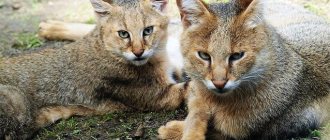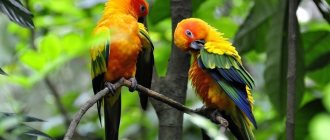The jungle cat (house) is a magnificent representative of the cat family, known to most of the world's population as the swamp lynx. Nowadays it is an expensive and rare pet for exotic lovers.
The graceful predator has become a sought-after animal for home breeding. The jungle cat combines the best features of a predatory and domestic representative of the family.
Story
The jungle cat is practically never found in the wild, limited to breeding in nurseries and zoos. Currently included in the Red Book list. The jungle cat or house in another way (Felis chaus) has been known since the times of ancient Egyptian civilization from the third millennium BC.
This species is also called the Nile cat in honor of its widespread distribution along the African river bank. It was the Egyptians, known for their unwavering love for the furry family, who were the first to dare to tame such a cat.
Population and species status
As a rule, this is a rather cautious animal, leading a secretive lifestyle, which does not allow obtaining complete and comprehensive information about the total number of these animals. Despite this, there is ample evidence that this species is on the verge of extinction in southwest and southeast Asia.
All jungle cat species are listed on CITES II, which regulates trade and protection of endangered species. In many states of India, as well as Afghanistan, it is prohibited to sell jungle cats, much less hunt them. The subspecies living on our territory is listed in the Red Book. The Caucasian subspecies is found within the territories of Ossetia, Chechnya, Ingushetia, as well as in the lower reaches of the Volga and on the Caspian coast.
Today it is known that the latest information about the Caspian jungle cats was in the 80s of the last century, although local residents claim that this predator is still found today. Since this animal has become increasingly rare in recent years, there are serious concerns that the total number has sharply decreased, and this is typical for many countries of the world. Such information indicates that such animals are on the verge of complete extinction, which cannot be allowed.
Where does the jungle cat live?
The natural habitat of jungle cats includes more than 25 countries, mainly inhabiting the northern banks of the Nile, the Caucasus, there are traces in Kazakhstan, as well as areas throughout Asia.
The jungle cat is also found in Russia, inhabiting the south of the Astrakhan region, Dagestan, and the lower reaches of the Caspian Sea. The animal does not like the cold, because its fur is not thick enough for a snowy winter. In total, 10 subspecies of wild predators are known, including the most common - the Caucasian reed cat.
The predator arranges its living space away from open spaces. It settles in an impenetrable reed thicket, among which it moves easily and often changes homes. Can settle in abandoned fox and badger holes.
The marsh cat is an excellent hunter, preferring to hunt for food at night. In winter, the predator can go for food during the day, tracking down prey in ambush. The wild jungle cat rarely rises to a height of more than 800 meters, preferring lowlands. At the same time, he skillfully hunts birds, jumping sharply high into the air.
Before purchasing, it is necessary to take into account the innate instincts of the pet and arrange a separate territory for it in your homes. In the wild, the animal does not really like to climb trees. The jungle cat is a good swimmer, so in addition to hunting for tasty ducks, he also likes to fish in the water.
Breed Features
The jungle cat is by nature a wild animal . Maintaining, raising and caring for him at home is quite difficult. He is very different from domestic cats, not only in appearance, but also in character.
Important! The Hausa jungle cat should not be confused with the Hausi breed. The latter was specially bred by crossing a jungle cat and a domestic cat.
Description and photo of the cat
In the wild, cats live in Kazakhstan, Dagestan, Afghanistan, Pakistan, India, Iran, Iraq, Syria, Sri Lanka, Thailand, and Egypt. They can have different colors and sizes. The color of the coat can be from red to brown, gray-brown to black. It was based on their color that they were divided into 10 subspecies .
The back and head of the Hausa are darker than the belly and tail, and there are stripes on the legs and tail. The structure of the coat is smooth, short, very thick. In winter, like all animals, it gets even thicker. The head is quite large with large erect triangular ears set high, and the muzzle is elongated.
Adults have tufts on their ears, giving them a lynx-like appearance and giving them the nickname "swamp lynx". Large, almond-shaped eyes, usually green or yellow in color. A distinctive feature of the House is its long, muscular legs. And the tail is short, about a third of the body long, which is about 20-30 centimeters, with a black tip.
These are quite large representatives of the cat family. Males, which are an order of magnitude larger than females, can reach a length with a tail of 125 cm, a height at the withers of up to half a meter and weigh up to 15 kg. The smallest jungle cats live in Thailand and Sri Lanka. They can weigh from 4 kg and be from 75 cm in length.
In nature, Hausas live in swampy areas overgrown with reeds, impassable thickets of bushes, and on the outskirts of the forest. They do not like open places and do not climb trees. Swamp lynxes are excellent hunters .
They catch birds, small rodents, gophers, hares and even small wild pigs. They swim very well. In this way they get their own fish and hide from persecution. They prefer to hunt in the dark. This is done less often during the day in cool weather. The house cat meows, but much louder than other cats and as if with a “bass”. In February and early March, jungle cats mate. Males fight for the right to own a female, arranging fights among themselves. A little more than two months later, kittens are born. Usually there are from three to six of them in a litter, but sometimes up to ten. Babies have clearly visible stripes on their fur, which disappear as they grow.
On the tenth day, the kittens' eyes open, they feed on milk for up to three months, and at five they are already completely independent. As a rule, this is where their communication with relatives ends, since cats are loners by nature. Houses live up to 14 years.
Did you know? Native speakers of English call the jungle cat “jungle cat”, as well as “reed cat” (Jungle cat, Reed cat).
Animal character
In two words, the character of a Hausa can be described as follows: it is a cat that walks on its own . He has the temperament of a wild cat and is not aggressive unless touched. Otherwise, troubles cannot be avoided. The owners of real jungle cats said that in fights they caused serious damage to shepherd dogs and mastiffs. At the same time, they get along well with cats.
Swamp lynxes are predators by nature, so it is better not to play with them. For the same reason, people who have children should not have them . They are hunters, so all domestic animals such as birds and rodents face an unenviable fate. If such a pet lives in a private house, then there will definitely be no mice, rats, or birds on the territory. Even neighbors' dogs that suddenly run into the territory can be strangled.
We advise you to familiarize yourself with the ten most expensive cat breeds in the world.
Character and behavioral characteristics
The house cat is a secretive, cautious predator that prefers night hunting to daylight. A wayward animal, being domesticated, will be able to find a common language with dogs and especially other cats, posing a threat to them only if it gets angry.
When getting such a pet, you need to be prepared for its active lifestyle and wild disposition. Houses are immensely curious; any sounds or movements can attract the attention of predators. The jungle cat chooses and recognizes one owner, loves constant attention, and constantly follows him.
It cannot be said that jungle cats have the character of a domestic cat. Houses, after being domesticated, have in common with traditional pets only their playfulness and affection for people. But these naturally wild animals will not lie on a bed for hours. An obstinate animal subtly senses the attitude of others towards itself, deprived of proper affection and attention, the pet is easily offended.
Choosing a kitten
Finding a real jungle kitten is not an easy task. They are bred only in nurseries, of which there are very few. You can also try to buy a kitten at an exhibition of elite breeds. If you finally make up your mind and find a kitten, ask the breeders to show its parents . You must make sure that they are indeed real jungle cats.
The type of pedigree papers that must accompany the kitten will only mean something to you and a certain circle of people who are involved in Houses. This is because the breed is considered wild and is not recognized by any of the clubs and federations. The price of a baby jungle cat is “biting”. It starts at five thousand dollars, but according to other sources, the bill goes into tens of thousands for a real Hausa.
Look carefully at the kitten, it should be active and playful. The coat and eyes should look good. Mother and kittens must be well-groomed. By the time you decide to take the baby, he should be treated with helminths and given the necessary vaccinations. As a rule, this is done before three months of age. We must remember that this is a wild animal. You can win over the baby by picking him up as early as possible.
Did you know? Jungle cat kittens are born with stripes that disappear with the onset of puberty: natural camouflage for the period until the animals can fend for themselves.
Maintenance and care
The wayward animal requires certain conditions of detention. Only a kitten can be tamed and raised. It can be kept at home, with a wide living space including an open area for walking.
The lack of ultraviolet radiation and space for active outdoor games will significantly worsen the pet’s health. The jungle cat feels quite comfortable at home, but keeping it is quite expensive.
They get used to the tray quickly, their fur sheds moderately, and they are in good health. Caring for a cat of this size will be a pleasure if you have a country house with an enclosure that allows you to walk it and a swimming pool for swimming. You should definitely purchase a home scratching post so that the jungle cat does not damage furniture and household equipment.
Organizing cat care
Home care includes hygiene control, walks in the fresh air, and grooming. In practical terms, caring for a pet is not difficult, especially if you manage to get along with the cat.
It is not advisable to keep a jungle cat in an apartment due to the lack of free space. The best option is a private house with a wide yard. Walking in the fresh air is strictly necessary for representatives of this breed to maintain normal levels of vitamin D and optimal metabolism of calcium and phosphorus.
Hygienic care includes the following measures:
- The jungle cat is a very clean breed. It is necessary to comb the fur only during the molting period. A special brush is used for this purpose. Maximum attention is paid to the combing procedure so as not to cause pain or discomfort to the pet. To do this, you can alternate between combing and brushing different areas of the body (mainly the space between the ears, head and back). You can try to perform the manipulation while the cat is sleeping. The resulting coarse clumps of hair are carefully cut off without trying to untangle them with your fingers.
- Washing paws after walks helps keep the spaces between the toes and the skin on the paws clean. For this purpose, you should purchase gel or liquid soap with surfactants (designed specifically for cats).
- Bathing should be carried out approximately once a week (this factor depends on the conditions of detention and the individual characteristics of the pet).
To prevent ticks and fleas, tablets, drops, and powder formulations should be used. Regular treatment of your pet for helminths is also important, especially when living in a private home.
A mandatory accessory for a predator is a nail sharpener. It is important to firmly fix the structure.
This can be a production model, or a homemade one: A pipe with ropes, a log.
Health and nutrition
The predatory nature determined the animal’s predominantly meat diet. The reed cat's diet consists of lean meat, live birds, reptiles, and small rodents. It is better to give your pet fish no more than once a week in measured portions.
Once a week, Hausas are given a fasting day to prevent obesity. The domesticated jungle cat eats according to natural instincts. Attempts to introduce only plant-based cereal foods will destroy the animal. It is highly not recommended to completely switch to dry cat food.
Proper care will increase a cat's lifespan to 14 years.
Important aspects to be observed:
- Feed kittens under one year old twice, adults - once a day;
- the diet should contain plant foods and live animals;
- additionally feed with special feed with minerals.
Pros and cons of the breed
It is advisable to purchase houses for the following reasons:
- they have a rather beautiful, unusual, graceful appearance;
- strong, resilient;
- active, love to play and interact with people;
- quickly get accustomed to the potty and scratching post;
- good hunters;
- friendly, gets along with other animals;
- become attached to the owner.
The disadvantages include the following:
- pets are quite large, so they require a lot of food;
- cats need to be walked;
- because of this, they must be frequently treated for fleas and helminths;
- You can feed only high-quality food.
Reproduction
The period of mating and rearing of the jungle cat's offspring occurs in the spring, affecting February. Before the mating season, the animal leads a solitary, solitary lifestyle; during the mating season, they can be found in small groups. There are always more males born in a litter than females. After five months, the kittens become independent and begin their own development path.
Habitat
Jungle cats love warm climates, which is why their favorite places of residence are Central Asia and the Caspian coast. They also live near the rivers of Africa (Nile), in Thailand, on the island of Sri Lanka, in Palestine, India, Indochina, in eastern Eurasia, and in the Caucasus. On the territory of the Russian Federation, in addition to the Caspian Sea, they can be found in Dagestan and in the lower reaches of the Volga River.
Cats hate open areas, so they go there in rare cases, without going far from their place of permanent deployment. Cats love bushes and reeds, where they feel most at ease and safe. Seals love to settle in coastal shrub and reed areas. Houses are not at all keen on building their homes, but prefer to settle in empty fox and badger holes. They do not live in them for a long time, constantly moving to new places for safety reasons. You can see cat tracks on the shore; jungle cats leave them on the shallows. They swim and dive beautifully, hunting both aquatic birds and fish.
If a cat lives in a mountainous area, then it does not like to climb higher than 800 - 1000 meters, preferring its bushy, often thorny wilds. The cat doesn’t particularly want to have contact with people, leading a secretive and cautious lifestyle. During winter cold and early spring, it can visit human villages, carrying out bandit raids, with the aim of stealing poultry, which it loves to feast on.
We can say that the jungle cat is an omnivore that feeds on almost everything that comes under its clawed paw. He is not averse to feasting on birds, catching them in flight; eggs from nests also form part of his diet. The cat also catches all kinds of rodents (field mice, gophers, martens), sitting by the mink for hours waiting for prey. The cat will not refuse all kinds of insects and even amphibians; it can eat frogs, lizards and snakes. A jungle cat can get itself a white hare, or even a small wild boar, if the opportunity arises. Hunts for birds that live on the water, catches fish. It is no coincidence that he dives and swims beautifully.
It’s worth focusing on how interestingly the cat catches fish. He slowly slaps his paw on the surface of the water, creating the impression of a floundering insect, luring fish
If it swims up, it immediately gets hooked by its sharp claws that are deftly released. To fish it out, the cat plunges its head directly into the water.
Among rural residents, the cat is known as a robber and thief who invades chicken coops, steals chickens and other poultry, and can even steal a small pig. True, the jungle cat does not do all this so often, because... prefers not to come close to human settlements. Basically, robberies occur in the cold winter and early spring, when it is difficult to obtain food.
How much does a jungle cat cost?
The reed breed is rare in Russia; you can purchase a pet through specialized nurseries. Breeders of the breed can be found at elite exhibitions.
Reed kittens are expensive, the price tag starts from three thousand dollars. Before purchasing, the individual must be three months old. During this period, the seller carries out a series of vaccinations for the cub:
- against calcivirosis;
- panleukopenia;
- rabies (must be carried out annually);
- herpes infection.
Kittens under 1 year old should eat plant and animal food 2 times a day, according to natural instincts. Children should be vaccinated on time and have the opportunity to walk in the fresh air.
Personality of the pet
By its nature, the jungle cat is a pronounced predator . Even domesticated breeds prefer a nocturnal lifestyle; they are extremely active, tireless and inquisitive. If keeping a wild animal in captivity is a dubious pleasure, then domesticated varieties are distinguished by a calm disposition, they are friendly and extremely interesting to keep.
The so-called Chausie , which is a hybrid of an Abyssinian cat and a jungle cat, are very popular today. In appearance, Chausies are practically indistinguishable from their wild ancestor, but at the same time they are calm and friendly animals that do not cause any difficulties when kept in captivity.
Do not forget also about the need for castration and sterilization of animals . This will not only prolong the life of pets, but will also save the homeowner from any difficulties with an unpleasant odor from an animal that may be marking its territory.
When keeping a jungle cat at home, you should definitely buy a scratching post and a large tray . These animals need open, free space and also love to swim, so you should bathe your pet from time to time.
Cat Chausie
There is a special, new breed, bred by crossing a wild reed breed (males only) with a regular cat - Chausie (Chausie). Externally, the pet is very similar to its father, but there are differences:
- the tips of the ears and tail are strictly black:
- smaller dimensions, weight;
- elongated tail.
It is more difficult to train such a cat to use a litter box, but its character is more flexible; with proper training, they become excellent companions. The parent’s genes make themselves felt with similar signs:
- love of open spaces;
- sociability;
- passion for bathing;
- large dimensions.
The distinctive features of the domestic version of the reed breed are reflected in physiological signs:
- hybrids have sensitive stomachs, it is strictly forbidden to feed your pets pork and grains;
- sterility of males until the third generation.
Conditions for keeping reed cats
If you have a small city apartment, then it’s better to think again whether you need such a wild cat with an unbridled disposition. The animal needs a place to play; lack of movement will provoke the development of diseases. If you live in a country cottage and you have the opportunity to equip an enclosure in the yard for keeping a reed cat, then this would be an ideal option.
Since the animal loves water, a pool or pond is very desirable for it. It would be good if there were fish swimming there. In a word, it is necessary to naturalize the conditions as much as possible so that the animal is comfortable.
It should be remembered that this is a predator that needs live food every day. Therefore, you will have to either buy mice or give the animal the opportunity to catch them on its own. It is unlikely that it will be possible to keep such an animal on dry food. The reed breed has good genes and good health, but vaccinations are still necessary.
With good care and proper upbringing, an active and active animal will live next to you, which will never let you get bored.
Description of the animal
House is a medium-sized cat, but much larger than any domestic cat. Its distinctive features include:
- Slender and muscular, not too long, the body of an athlete, reaching one meter together with the tail in especially large specimens.
- The tail is significantly shorter than that of most cat species (up to 30 cm).
- The paws are long, slender and muscular, ending in large pads with powerful claws.
- High-set, medium-sized ears may have small tufts.
- Like all wild cat species, the Hausa has light spots on the back surfaces of its ears - false “eyes”. It is along them that the brood, following its mother at dusk, orients itself.
- The color of the short, dense coat is ticked - from yellowish-gray to brick-brown with noticeable gray hair.
- The muzzle is large, heavy, slightly elongated, with an elongated nose ending in a convex brick-colored lobe.
- The eyes can be topaz or emerald shades, depending on the shade of the coat.
- Large individuals weigh a little more than twenty kilograms. Domesticated ones are usually smaller than their wild relatives.
- In captivity they can live more than fifteen years, wild individuals live a little less.
This strong, large and heavy animal for a domestic cat is very graceful and agile.











